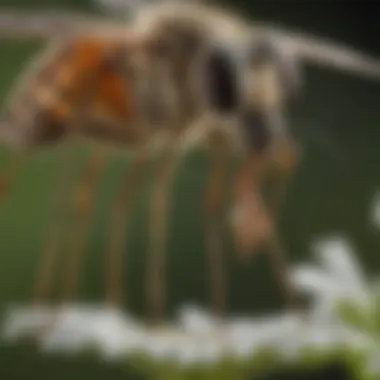Pyrethrum Spray for Mosquito Control: Efficacy Unveiled


Intro
Mosquitoes have long plagued human populations, often spoiling outdoor gatherings and increasing the risk of various diseases. Understanding the factors that contribute to their existence is essential for effective pest control. Pyrethrum spray emerges as a notable solution in managing these pests. It is crucial to examine what makes mosquitoes thrive, their life stages, and how this knowledge lays the groundwork for effective control measures.
Understanding the Pest
Identification
To tackle mosquito issues effectively, one must first identify these pests. Mosquitoes belong to the family Culicidae. They are characterized by a slender body, long legs, and a unique proboscis used for feeding. Common species include Aedes aegypti, Culex pipiens, and Anopheles gambiae. Recognition of these species aids in implementing targeted measures, as different types may respond differently to pest management strategies.
Life Cycle
The mosquito life cycle consists of four stages: egg, larva, pupa, and adult. Understanding this cycle is imperative for homeowners seeking effective control.
- Egg: Laid in stagnant water, eggs can hatch in a couple days.
- Larva: These aquatic stages feed on organic matter.
- Pupa: Unfeeding stage where they prepare for adulthood.
- Adult: Emerges to continue the cycle, mating and laying eggs.
Each stage offers unique vulnerabilities to treatments, making timing and selection of control methods vital.
Pest Prevention Strategies
Environment Modification
Creating an environment less conducive to mosquitoes can drastically cut down their populations. Homeowners should eliminate standing water sources, such as clogged gutters and overwatered gardens. Regular lawn maintenance, including mowing and trimming shrubs, can also reduce resting sites for adult mosquitoes.
Physical Barriers
Installing screens on doors and windows is a simple yet effective way to keep mosquitoes out. These barriers prevent mosquitoes from entering living spaces, allowing for a more comfortable home environment.
Applying mosquito repellents, like those containing DEET or picaridin, on exposed skin offers additional protection when venturing outdoors.
Control Methods
Chemical Control
Here, pyrethrum spray takes center stage. This natural insecticide comes from the chrysanthemum flower and targets the nervous system of insects, proving effective in combating mosquitoes.
Homeowners can apply pyrethrum spray in targeted areas, particularly in places where mosquitoes are likely to breed or rest. It’s essential to follow all application instructions to ensure efficacy and safety.
Biological Control
In contrast to chemical methods, utilizing biological control focuses on introducing natural predators or pathogens. This could include nematodes, which prey on mosquito larvae. Such methods contribute to a balanced ecosystem and can provide long-lasting results.
Integrating various strategies, including prevention and control methods, enhances the effectiveness of mosquito management and reduces reliance on any single method.
This comprehensive understanding of mosquito behaviors and effective management strategies provides vital insights for households aiming to safeguard their health and well-being against these persistent pests.
Preface to Pyrethrum
The use of pyrethrum as an insecticide has grown in popularity due to its effectiveness in controlling various pests, notably mosquitoes. This section introduces the significance of pyrethrum in pest management strategies, highlighting its natural origin and suitability for household use. Understanding the properties and historical context of pyrethrum can better inform homeowners on how best to utilize this product in their environments. Importantly, this understanding gives insight into both the efficacy and safety associated with its application.
Definition and Origin
Pyrethrum originates from the dried flowers of the chrysanthemum plant, particularly Chrysanthemum cinerariifolium and Chrysanthemum coccineum. These flowers contain natural compounds known as pyrethrins, which serves as active ingredients effective against insects. The historical use of pyrethrum dates back to ancient times, primarily in regions like East Africa and the Mediterranean. Historically, it was used as a botanical insecticide before modern chemical alternatives emerged. Its relatively low toxicity to humans and pets makes it an attractive alternative for pest control in residential settings.
Cultural and Historical Relevance
Culturally, pyrethrum maintains a significant presence in various societies. In many communities, it is seen as a traditional remedy for insect control, often employed in households for its effectiveness and lower environmental impact. Its historical relevance is reflected in agricultural practices, where pyrethrum has served farmers for generations to protect their crops. Today, as awareness around chemical pesticides' effects grows, pyrethrum’s role is being re-evaluated and revived. By understanding the depth of its traditional uses, modern consumers can appreciate not just the efficacy of pyrethrum spray against mosquitoes but also its roots and the progressive shift towards more sustainable pest management solutions.


Chemical Composition of Pyrethrum
Understanding the chemical composition of pyrethrum is essential for grasping its role as an insecticide, particularly for mosquito control. Pyrethrum is derived from the dried flower heads of the Chrysanthemum cinerariifolium and related species. The effectiveness of this natural insecticide hinges on its unique active constituents, primarily pyrethrins, which are responsible for its insecticidal properties. The chemical makeup not only determines how effectively pyrethrum can eliminate mosquitoes but also informs users about safety and environmental considerations.
Active Ingredients
The principal active ingredients in pyrethrum are six naturally occurring compounds known as pyrethrins. These compounds are responsible for the rapid knockdown effect observed in many insects, including mosquitoes. They disrupt normal neurological functions, leading to paralysis and, eventually, death. The pyrethrins are categorized as follows:
- Pyrethrin I: Known for its efficiency against adult mosquitoes.
- Pyrethrin II: Displays similar properties but has different action times.
Alongside these primary components, pyrethrum formulations may contain additives that enhance its stability and efficacy. Various factors, such as concentration and formulation (like emulsifiable concentrates), affect the performance of pyrethru sprays.
Mechanisms of Action
The action of pyrethrins revolves around their impact on the nervous system of insects. Upon contact or ingestion, pyrethrins bind to sodium channels in the insect's nerve cells, leading to prolonged openings. This excessive sodium influx disrupts normal nerve signaling. As a result, insects experience symptoms like hyperactivity, followed by incapacitation and death.
Some key points about their mechanisms include:
- Rapid Knockdown: This allows for immediate impact on mosquito populations.
- Low Toxicity to Humans and Pets: When applied correctly, it has minimal effects on non-target species, which is a benefit over synthetic insecticides.
- Resistance Management: Unlike some chemical insecticides, the natural origin of pyrethrins makes it less likely for mosquitoes to develop resistance, though it can still occur over time.
"The efficacy and safety profile of pyrethrum makes it a favored choice in integrated pest management strategies, especially in residential areas."
In summary, the chemical constituents of pyrethrum, particularly the active pyrethrins, underline its efficacy and strategic importance in controlling mosquitoes. Understanding these elements equips users with knowledge crucial for the responsible application and maximizes its potential while minimizing risks.
Efficacy of Pyrethrum Spray Against Mosquitoes
Understanding the efficacy of pyrethrum spray against mosquitoes is crucial for anyone considering its use as a pest control method. This section delves into how effective pyrethrum spray can be, based on scientific research and practical applications. It highlights various benefits this organic insecticide offers. Homeowners often seek reliable solutions for mosquito control, and knowing the reliability of pyrethrum spray can assist in making informed decisions.
Research Studies and Findings
Multiple research studies have analyzed the efficacy of pyrethrum spray in combating mosquito populations. Notably, a study published by the Journal of Vector Ecology examined pyrethrum's effectiveness in field conditions. The conclusion indicated that pyrethrum spray significantly reduced adult mosquito populations within a short period after application.
Furthermore, field tests have demonstrated that pyrethrum is effective against various species of mosquitoes, including Aedes aegypti and Culex pipiens. These species are known carriers of diseases such as dengue and West Nile virus. The testimonials from these controlled experiments indicate a substantial decrease in mosquito activity.
In another study conducted by entomologists from a prominent university, it was shown that mosquitoes exposed to pyrethrum show signs of agitation and disorientation. This behavior disrupts their feeding and mating, reducing their overall population. Research suggests the effects can last from a few hours to several days, depending on environmental factors.
Comparison with Other Insecticides
When comparing pyrethrum spray with other insecticides, several factors such as effectiveness, safety, and environmental impact come into play. In general, pyrethrum has been found to be a competitive option. For instance, conventional insecticides often involve synthetic chemicals, which carry potential risks for humans and pets. In contrast, pyrethrum, derived from chrysanthemums, is considered a safer alternative. Still, effectiveness can vary based on concentration and formulation.
In a comparative study, it was noted that while pyrethrum caused rapid knockdown of mosquitoes, products such as DEET and permethrin also showed longer residual effects. However, these alternatives may pose health risks when used extensively. Homeowners often prefer pyrethrum for its natural origin and reduced toxicity.
"Natural insecticides like pyrethrum provide a balance between effective pest control and safety for the environment and human health."
Thus, it is evident that pyrethrum spray holds its ground in terms of efficacy when stacked against traditional synthetic insecticides. This information is invaluable for those engaged in integrated pest management programs and looking for a viable option to control mosquito populations.
Application Methods of Pyrethrum Spray
Applying pyrethrum spray effectively is crucial for maximizing its benefits in mosquito control. Understanding the proper techniques and timing for using this natural insecticide ensures optimal results while minimizing any potential drawbacks. This section delves into practical methods for application, concentrating on equipment used and the best practice for frequency and timing, ultimately reinforcing the value of pyrethrum in pest management.
Spray Techniques and Equipment
The choice of spray techniques and equipment can significantly influence the effectiveness of pyrethrum sprays. Handheld sprayers, such as pump sprayers or trigger sprayers, are often used for small areas, offering flexibility and ease of use for homeowners. These devices can be filled directly from the bottle and can reach corners or limited spaces effectively. Alternatively, motorized sprayers are more efficient for larger outdoor areas, allowing for broader coverage in less time. These machines can deliver a finer mist, reducing the amount of pyrethrum wasted during application.
When utilizing pyrethrum sprays, it is essential to consider the nozzle type. Adjustable nozzles provide versatility, enabling users to switch from a concentrated stream to a fine spray, depending on the target area and infestation level.
Protective gear is also vital during application to ensure safety. Gloves, masks, and protective eyewear will limit exposure to chemicals and enhance user confidence during spraying. Taking these safety measures is not only prudent but necessary for effective handling of these substances.


Timing and Frequency of Application
The timing and frequency of applying pyrethrum spray plays a crucial role in its efficacy against mosquitoes. Mosquitoes are most active during dusk and dawn, which makes these times ideal for treatment. Spaying during these peak times increases the likelihood of contact with the target pests.
Frequency of application is another important consideration. Generally, it is recommended to reapply pyrethrum spray every one to two weeks depending on environmental factors like rainfall or heavy winds, which can diminish its effectiveness more rapidly. Weather conditions should not be overlooked; applying pyrethrum during dry and calm days maximizes its persistence in the treated area.
To summarize the guidance:
- Choose the right equipment: Handheld or motorized sprayers can determine coverage effectiveness.
- Consider nozzle types for specific applications.
- Spray during peak mosquito activity hours, primarily at dusk and dawn.
- Reapply every one to two weeks, adjusting to weather conditions.
Consistent application will fortify your defenses against mosquitoes while ensuring the environment remains manageable for non-target species.
These methods form the backbone of effective pyrethrum spray usage, enabling homeowners to safeguard their living spaces from mosquito infestations in a strategic manner.
Safety Considerations
The topic of safety when using pyrethrum spray for mosquito control holds significant relevance in our daily lives. Understanding the possible health effects, both for humans and our pets, along with the impact on the environment, is crucial for making informed decisions. Balancing effective pest control with safety is essential for those who wish to maintain a livable home environment. The conscientious application of pyrethrum requires awareness of its effects to minimize any potential risk associated with its use.
Health Effects on Humans and Pets
Pyrethrum, derived from chrysanthemum flowers, is often considered safer than synthetic insecticides. However, it is still vital to understand its potential health effects. Exposure can occur through inhalation, skin contact, or ingestion. Common symptoms may include skin irritation, respiratory issues, or allergic reactions.
- For Humans: Prolonged exposure to pyrethrum may lead to several issues. Some may experience headaches or dizziness, while others could face more severe allergy symptoms such as rashes or asthma attacks. It is advisable to apply the spray in a well-ventilated area and keep children and vulnerable individuals away during treatment.
- For Pets: Pets can also be sensitive to pyrethrum. Cats are particularly susceptible as they lack the necessary enzymes to process certain chemicals found in pyrethroids. Symptoms in pets may include drooling, tremors, or in severe cases, seizures. Therefore, ensuring pets are safely distanced during application is crucial.
Taking these precautions can significantly reduce health risks while still providing effective mosquito control. Maintaining a safe environment post-application involves waiting until the spray has dried completely and keeping living spaces well-aired.
Environmental Impact and Non-target Species
The environmental implications of using pyrethrum sprays are complex. While pyrethrum is often recognized for its relatively low toxicity to humans and pets, its impact on non-target species cannot be ignored. It can be harmful to beneficial insects like bees and butterflies.
- Non-target Species: Pyrethroids can disrupt local ecosystems. While they may effectively kill mosquitoes, the unintended consequences include harm to other insects essential for pollination and ecological balance.
- Water Contamination: Run-off from treated areas can pose risks to aquatic life and habitats. Hence, it is vital to avoid spraying near bodies of water and to follow application guidelines.
To mitigate these impacts, homeowners should consider integrated pest management techniques. This includes utilizing physical barriers, like screens, and maintaining proper landscaping to reduce mosquito breeding sites.
"Careful consideration of safety measures enhances the effectiveness of pyrethrum while minimizing potential risks to health and the environment."
By adopting a balanced approach, homeowners can enjoy the benefits of effective pest control without compromising safety for their family, pets, and the environment.
Integration into Pest Management Strategies
The integration of pyrethrum spray into pest management strategies is vital for achieving effective mosquito control. This topic is particularly pertinent to homeowners seeking solutions that balance efficacy and safety. The use of pyrethrum is not only about application but requires understanding its role within broader pest management frameworks.
Incorporating pyrethrum into a pest control plan allows for a more holistic approach. By utilizing its fast-acting nature against mosquitoes, the strategy can reduce populations without relying solely on synthetic insecticides. Furthermore, integrating this natural solution promotes the idea of sustainability and eco-friendliness in pest management.
Complementary Approaches
To maximize the effectiveness of pyrethrum spray, it is essential to pair it with other pest management techniques. Here are some complementary methods:
- Source Reduction: To mitigate mosquito breeding, eliminate standing water around properties. This includes cleaning gutters, emptying containers, and maintaining pools.
- Physical Barriers: Installing screens on windows and doors can prevent mosquitoes from entering the house, thus decreasing the need for chemical controls.
- Natural Predators: Encourage the presence of mosquito predators such as bats and birds, which naturally control mosquito populations.
These approaches not only enhance the effectiveness of pyrethrum but also contribute to a more comprehensive pest management strategy that reduces reliance on chemicals, ultimately protecting the environment.
Role in Integrated Pest Management (IPM)
Pyrethrum plays a crucial role in Integrated Pest Management (IPM), which focuses on long-term prevention of pests through a variety of methods. Here are some key points about its role in IPM:


- Monitoring: Regularly check for mosquito activity and breeding sites allows for timely interventions. By using pyrethrum spray as part of an IPM approach, homeowners can effectively react if mosquito populations surge.
- Threshold Levels: Establish acceptable thresholds for mosquitoes to guide the need for intervention. If counts surpass these levels, a pyrethrum application might be warranted.
- Resistance Management: Because pyrethrum acts differently compared to synthetic insecticides, using it can help delay the development of resistance in mosquito populations.
"Integrating pyrethrum into pest management strategies promotes environmental stewardship while ensuring effective mosquito control."
Future Outlook for Pyrethrum Spray Usage
The subject of future outlook for pyrethrum spray usage holds significant weight in discussions surrounding pest control strategies. As environmental awareness grows, there is an increasing demand for methods that effectively control mosquito populations without causing drastic ecological disturbances. Pyrethrum, derived from chrysanthemum flowers, has carved a niche in this paradigm of integrated pest management. Its natural origin makes it appealing to a demographic increasingly interested in sustainability.
Emerging Technologies and Innovations
As innovation permeates the pest management field, pyrethrum spray is positioned to benefit from advancements in formulation and application technologies. One notable development is the encapsulation technology that can enhance the stability of pyrethrum in various conditions. This approach aids in prolonging its efficacy when subjected to environmental stresses such as sunlight or moisture.
Moreover, the integration of smart application devices utilizing IoT (Internet of Things) can dramatically change how pyrethrum is deployed. These devices could monitor mosquito activity and optimize spray timings, ensuring effective coverage while reducing waste. This precision in application promises not only greater efficacy but also minimizes the impact on non-target species.
Additionally, biotechnology might deliver new strains of pyrethrum with improved insecticidal properties, making it more competitive against synthetic alternatives.
Potential Regulatory Changes
The regulatory landscape is crucial to the future use of pyrethrum spray. Presently, regulations surrounding pest control products focus heavily on safety and efficacy. As more homeowners seek greener pest solutions, lawmakers may respond to public demand by reevaluating standards for natural pest management products.
For instance, an increase in studies validating the safety and environmental benefits of pyrethrum could lead to more favorable regulations. There may also be discussions on labeling requirements that clearly communicate the benefits and risks of using natural insecticides when compared to more toxic compounds.
Changes in international standards could also affect the market. A global shift toward sustainable practices could catalyze local governments to revise how pest control products are treated, positively influencing the pyrethrum market.
"Innovation combined with wise regulation can set a new standard for pest management, ensuring that efficacy and safety go hand in hand."
User Experiences and Testimonials
The section on user experiences and testimonials serves a vital role in providing real-world context to the theoretical and scientific information presented earlier in the article. By including feedback from individuals who have utilized pyrethrum spray for mosquito control, this section establishes credibility and allows potential users to relate practical outcomes to their own circumstances. It highlights the efficacy of the product not just in controlled studies, but in actual home environments. This empowers homeowners with important insights that can guide their choices.
Case Studies from Homeowners
Homeowners have reported varied experiences with pyrethrum spray, with many noting significant relief from mosquito infestations. For instance, one homeowner in Florida shared how the application of pyrethrum spray in and around her garden drastically reduced the mosquito population during the summer months. She stated that it was easy to use and effective, especially when combined with regular application during peak mosquito breeding times. This demonstrates the practical benefits of timely and systematic use of the spray.
Another case involved a family who struggled with mosquitoes near a stagnant pond. They used pyrethrum spray around the perimeter and noted immediate results. The sprays not only reduced mosquito activity but also provided them peace of mind while entertaining outdoors. This aligns with findings from studies which suggest that targeted application can yield favorable results against mosquitoes.
Homeowners also valued the quick action time of the spray, with reports that it works within minutes. This is particularly crucial for individuals planning outdoor gatherings or activities where mosquitoes can be especially bothersome.
Feedback from Pest Control Professionals
Pest control professionals who use pyrethrum sprays regularly affirm their effectiveness in integrated pest management strategies. They often highlight that pyrethrum's rapid knockdown effect is a key advantage when dealing with mosquito populations. One professional emphasized that using pyrethrum in tandem with other IPM approaches not only combats mosquitoes effectively but also protects beneficial insects in the environment.
Moreover, feedback indicates that pyrethrum's natural origin is a significant selling point. Clients seeking eco-friendly pest control options tend to prefer it over synthetic alternatives. Technicians appreciate that they can explain its benefits to conscientious homeowners who value safety and sustainability.
Across various testimonials, pest control experts also noted that while pyrethrum is effective, it is crucial to combine its application with other preventative measures, such as removing standing water and using screens on windows. This expert insight underscores the importance of a holistic approach to mosquito control in residential settings.
"Pyrethrum spray is a powerful tool. It fits well in our overall strategy and keeps our clients happy and safe." - A pest control technician
Ultimately, the real-world experiences shared in this section enrich the article, guiding both homeowners and professionals in making informed decisions regarding the use of pyrethrum spray for mosquito management.
End
The role of pyrethrum spray in mosquito control cannot be overlooked. This article emphasizes the significant benefits and considerations surrounding its use. Understanding the strengths and limitations of pyrethrum equips homeowners and pest control professionals with knowledge necessary for effective management of mosquito populations.
Summary of Key Points
- Chemical Efficacy: Pyrethrum spray contains natural compounds that act quickly against mosquitoes. Its active ingredients disrupt the nervous system of pests, leading to their rapid incapacitation.
- Application Strategies: Appropriate techniques for applying pyrethrum spray are crucial. Results depend on correct timing, frequency, and method of application. Factors like wind, temperature, and humidity also play roles in efficacy.
- Safety Concerns: While pyrethrum is derived from chrysanthemum flowers and is generally safer for humans and pets than synthetic alternatives, safety precautions should still be observed. Understanding dosages and potential resistance is essential.
- Environmental Impact: Pyrethrum has a lower environmental footprint compared to many synthetic insecticides, making it a preferred choice for organic gardening and pest management.
- Integration in Pest Management: Pyrethrum spray works effectively as part of broader Integrated Pest Management (IPM) strategies, which combine multiple methods for a sustainable approach to pest control.
Final Recommendations
- For Homeowners: Consider incorporating pyrethrum spray into your routine pest control measures, especially during mosquito peak seasons. Utilize it in conjunction with other preventive strategies, such as removing standing water and using mosquito repellents.
- For Pest Control Professionals: Educate clients about the benefits of pyrethrum as a part of pest management strategies. Monitor and adjust applications based on the specific needs and environmental factors of each site.
- Ongoing Research and Education: Stay informed about potential regulatory changes regarding pyrethrum. Keeping abreast of emerging findings related to its efficacy and safety will enhance its application.
By thoughtfully integrating pyrethrum spray into pest management efforts, stakeholders can significantly reduce mosquito populations. Through careful consideration of application methods and an understanding of safety measures, the use of pyrethrum can yield satisfying results.







